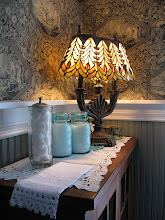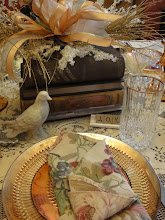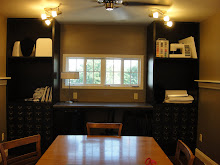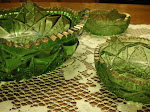End of July while browsing through Featherweights on Ebay . . . something exciting caught me by surprise. An early 1930s Featherweight.
From the seller's photos--I could see the chrome hand wheel, an early machine feature on machines between 1933 through 1947.
Then, I saw the pale teal green interior of the black case and tray.
Note the cutout circle in the tray, to allow for the spool pin to clear when putting machine and tray away in its case.
The seller provided no statement of condition (didn't mention if it still sewed).
Didn't mention if it had its original bobbin case. I didn't ask. I didn't want to look too eager about my intentions to bring this machine home to Wisconsin. It came from an estate sale in Maryland.
Another Clue:
The school bell style bobbin thread guide on 1933 and 1934 models, and some 1935. I understand the school bell bobbin thread guide was fragile, and by the end of 1935 was replaced with different type. But also there was a portable table being manufactured for the early Featherweights, and Singer relocated a new flatter style bobbin thread guide, so it would fit the table.
Bottom right of photo - the unique school bell bobbin thread guide.
Next clue:
Confirmation - its serial number AD549140. Commission Date 3 October 1933
First 10,000 Singer Featherweights were manufactured in 1933, with commission date of 3 October.
The first machine serial numbers were: AD541546 through AD551545.
Of this run, a couple hundred were pulled intermittently off the line and fitted with a red and gold badge to be introduced and sold at the 1933-34 Century of Progress Show in Chicago, (Chicago World's Fair). Machines with the Chicago badge can fetch up to $5,000.
At the height of the Great Depression in 1933: 20% unemployment, a loaf of bread cost 8 cents, and a gallon of gas 10 cents. The Singer Featherweight cost $125. The red and gold badged machines at the Chicago World's Fair sold for $150 each.
The Singer 221 Featherweight weighs 11.25 lbs. It's a tiny machine, that proved to be a workhorse. Favorite machine of quilters in quilting groups. Very portable, very reliable.
***
How did the nickname Featherweight start?
I read one theory. In 1916 the Indian motorcycle was introduced. By today's standards the 1916 Indian was little more than a bicycle with a motor. It was called a 221cc Featherweight. Perhaps one of the Singer designers was inspired by this.
When my 1933 Singer Featherweight arrived, there were pros and cons about its packaging:
Pro
Pro
No-no
After all the careful bubble packing . . . the metal foot control is not wrapped and is sitting metal to metal in the harp area on the bedplate.
Not wrapping the foot control will chip and scratch the bedplate. I'm going to say it out loud . . . "this was such a dumb thing to do."
Worse, it was put in the harp area upside down, with its cushion feet up in the air, and its metal speed control button touching, scratching, chipping away the enamel on the bedplate.
Recently, I purchased a 1934 (commission date 30 Dec ) Singer 221 Featherweight shipped to me in the same reckless way, with its unprotected metal foot control sitting in the harp area on the bedplate.
Spread the word: To avoid chips and scratches . . .
make a polar fleece pouch to wrap the foot control when storing or traveling.
I have an upcoming appointment with R & L Electric to discuss what to do about the scrapes on the power cord. Perhaps he'll suggest a repair, but I have a backup plan to install a new cord replacement. I confess, I haven't plugged in the 1933 yet. I am waiting for a cue from R & L to drive to their shop to evaluate the machine/motor/power cord. They are really busy right now and I am behaving and being patient, waiting for my turn.
Update: Scott from R & L Electric looked over my machine, then slowly added electrical current. The 1933 is running fine. No smell coming from the motor. The power cord has a bad scuff, but fixed with electrical tape.
I'm busy everyday working in the studio sewing things for shows. My next show is Shiocton WI August 19-20.
Patience, and Reminiscing:
Grandpa Bert used to tell me, "a place for everything, and everything in its place." Likewise "a time for everything, and everything takes time." Wicked Witch of the West, "all in good time my pretty, all in good time."
Here are the photos I took as I unpacked the 1933. The decals are awesome.
Things that make my 1933 different from others:
Early Featherweights like mine have Singer logo sitting high on the light bulb housing. First hundred or so first run Featherweights had a single bud decal, where as my machine 7594th manufactured has the enhanced center bud decal with arms.
Unmarked bobbin wheel (Singer number added later)
Wheel housing has decal ending in a single loop
1933 Slight curve in the take up thread guide. By the end of 1935 the guide was straight, no curve.
Subtle differences in decals, single loop
School Bell Bobbin Thread Guide
(right) Decals wrap around the bedplate ending near the light bulb switch.
Hey, here's a good fix. A band aid.
I put my granny shoes on the table, so you can get an idea of how little this machine is.
Granny shoes found at Goodwill. The shoes are two sizes too big for me, but I'll figure a way to make them snug so I can wear them to our Halloween Weekend Victorian House Tour and Craft Show Sat-Sun October 28-29, 2017.
Inside the machine--its original bobbin case 45750
Unpacking the machine; the spool pin cover ajar. That's strange.
Original Black Case with Brass Closures
Minor gluing repairs to be done. Fabric is gauze thin.
I'll post again later, after I make the repairs to the case, add new belt, light bulb, 4 rubber cushion feet and complete my appointment with R & L to check out electrical.
Look at the smashed cushion bed feet (upper left and right of the photo).
I suppose the smashed rubber feet are caused by the person sewing, leaning on the machine? What's your guess?









































.jpg)
















Hello Linda, It is interesting the trail of use and personalization each owner of an object has left behind, making even mass-produced objects unique, as with your rare Featherweight sewing machine.
ReplyDeleteI know that you have to update certain parts in order to make the machine usable, but recently I have had the opposite problem. I got a very old musical instrument in original condition that if I restored it to make it play, I would have to remove too much of the history embedded in the original pads, springs, etc.
--Jim
Hello Jim, wonderful to hear from you. I'm always interested in hearing about your collections. How have you been?
ReplyDeleteYou make a great point (yes or no to update an old item). I hadn't thought about how updating parts on my Featherweight machine changes it original condition forever, and once changed it isn't original anymore. I re-read your words several times, ". . . the trail of use and personalization each owner of an object leaves behind."
Your very old musical instrument's original parts are precious and desirable. And you made a very good decision not to change its original condition to make it playable.
I'd like to hear more about your musical instrument. Your clues: original pads, springs, etc. make me curious what type of instrument it is. I love your posts on Mystery Objects. Is it a woodwind instrument?
***
I love to sew and I sew nearly everyday. I am sentimental about my old sewing machines collection. I know the collection I leave behind will be in a state of readiness for anyone to sit and sew on them. That makes me happy.
In the hallway upstairs--I have a 1910 Singer vibrating shuttle model 128, 3/4 size sewing machine. It sits on a credenza among photographs of the Quien children who lived in our old house. Several times a week, I walk by the 1910 and turn its hand crank. I get a thrill listening to it, tink, a-tink, a tink. There's no thread in it right now, but it sews like a charm when threaded. She's a fancy one with La Vencedora decals--fancy scrolls of gold, green, and red. No parts needed on this lovely machine, but I did lots of cleaning, oiling, polishing.
Thanks for the great post! Someone just GAVE me number AD542486 - the 940th made! It's in a bit rougher shape than yours, but was stored with a lot of grease so it hums like a baby! The owner scratched their name and address into the font side. Not a nice thing to do, but I can prove who owned it!
ReplyDeleteHi Sally. Thank you for dropping by and telling me about your 1933 Featherweight. I looked at your website and saw all the beautiful things you create, teaching classes, and speaking. You are a busy gal and very very talented. So nice to hear from you.
DeleteSmashed feet are probably smashed because they are 84 years old and the rubber compound has deteriorated. I also have some older Singer 221's and 301's that had the same problem.
ReplyDeleteBeautiful! Lucky you finding a school bell. I am enjoying a 1936 featherweight, and last week my neighbors gifted me with another, a 1946 featherweight. My dream machines!
ReplyDelete